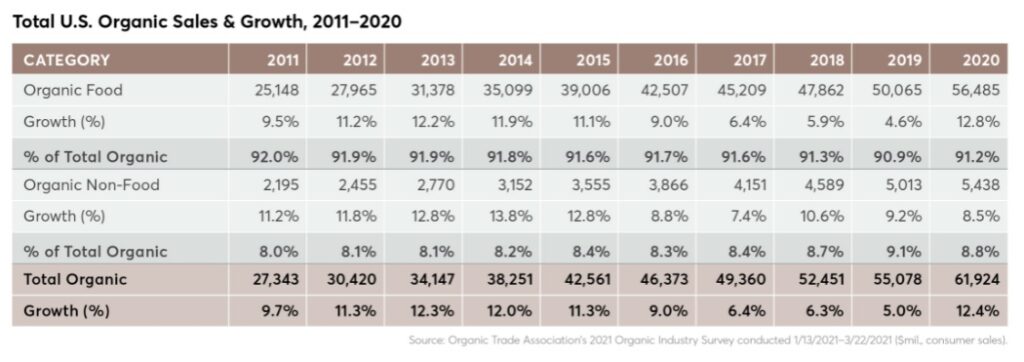US SALES OF ORGANIC PRODUCE SOAR TO $62 BILLION
Greater health awareness, fuelled by the onset of the Covid-19 pandemic, helped organic food and non-food sales in the US to surge last year by 12.4% to reach $62 billion (€52.8bn) based on one survey’s findings.
Organic food made up the vast bulk of the sales at $56.4 billion, up a record 12.8% which meant that in 2020, almost 6% of all food sold in the US was certified organic, with some categories performing exceptionally well.
According to the Organic Trade Association (OTA) – which represents close to 10,000 organic businesses – the growth rate was more than twice that of 2019’s steady 5% and marked the first time that total sales of organic products topped $60 billion mark.
The 2021 Organic Industry Survey (available to buy) was conducted in the first quarter of 2021 and points to black beans, flour, and chicken broth as being in high demand. “They are not typically out of stock, but they were in 2020,” said the OTA. “In 2020, organic’s reputation of being better for you and the planet, positioned it for dramatic growth. In almost every organic food aisle, demand jumped by near-record levels.”
The closure of restaurants – some permanently – and the slide in take-out meals due to the pandemic shifted consumer spending almost overnight to groceries “with traditional staples and pantry and freezer items flying off the shelves” according to the OTA. Eating three meals a day at home also upended the market in favour of organic food.
US consumers made high-quality choices
Laura Batcha, CEO and Executive Director of the OTA commented: “The pandemic caused abrupt changes in all of our lives. Good, healthy food has never been more important, and consumers have increasingly sought out the organic label. Organic purchases skyrocketed as shoppers choose high-quality organic to feed their families.”
The most in-demand organic foods were led by fresh product, but others too have helped reshape the market:
- Fresh produce topped the list with sales rising by nearly 11% to $18.2 billion
- Frozen and canned fruits and vegetables were popular with frozen sales rising by more than 28%.
- Total sales of organic fruit and vegetables (including frozen, canned and dried products) topped $20 billion
- More than 15% of fruits and vegetables sold in the US are now organic.
- Organic flours and baked goods were up by 30% as bread making and cookie baking led the demand
- ‘Meal support’ products such as sauces and spices pushed the $2.4 billion condiments category up 31% and organic spice sales more than trebled those of 2019, growing by 51%.
- Meat, poultry and fish, the smallest of the organic categories at $1.7 billion, had the second-highest growth rate of nearly 25%.
Constraining factors and non-food
The high demand has, however, led to the development of some constraints. OTA’s Director of Education and Insights, Angela Jagiello, says: “Across all the organic categories, growth was limited by supply which caused producers, distributors, retailers and brands to wonder where numbers would have peaked if supply could have been met.”

The bottlenecks were not just in ingredients, but packaging like bottle lids, pouches and corrugated cardboard, bottles for dietary supplements, as well as workers and drivers to transport product, making it hard for producers to ramp up to meet consumer demand.
The organic non-food category did not see the same growth in 2020 as food. Its growth of 8.5% to $5.4 billion was slightly below the 9.2% reported in 2019. Reflecting the pandemic – as with the conventional market – sales were driven by personal hygiene, hand sanitizers and cleaning products. Organic household products saw record growth of 20%.
However, textiles and fibres, the biggest organic non-food category, saw sales slow as stores closed and weaker players fail, so clothes-buying dipped. For the year, US organic fibre, like linens, clothing and other textiles, grew at a rate of 5%, compared to 12% in 2019, reaching sales of $2.1 billion.
Expectations for 2021 in US market
Last year’s growth rates for organic foods are not expected to continue this year, but they will retain a strong footing. The OTA says: “It’s anticipated that the grocery industry at large will get a lasting lift from the pandemic for the foreseeable future.”
Batcha said: “Some of the changes seen last year are here to stay. “What’s come out of Covid is a renewed awareness of maintaining our health, and the important role of nutritious food. For more consumers that means organic. We’ll be eating in restaurants again, but many of us will also be eating and cooking more at home. We’ll see more organic everywhere – in the stores and on our plates.”
Join us at SIAL Paris as exhibitor Join us at SIAL Paris as visitor
